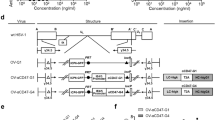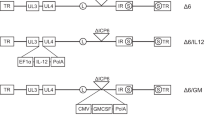Abstract
Oncolytic viruses (OVs) are being used as anticancer agents in preclinical and clinical trials. Propagation of OVs inside infected tumors is critical to their efficacy and is mediated by the productive generation of progeny OVs within infected tumor cells. In turn, this progeny can spread the infection to other tumor cells in successive rounds of oncolysis. Previously, we had found that, in rats, cyclophosphamide (CPA) pretreatment increased infection of brain tumors by an intra-arterially administered herpes simplex virus type 1 OV, because it inhibited activation of complement responses, mediated by innate IgM. We also have previously shown that other pharmacologic inhibitors of complement, such as cobra venom factor (CVF), allowed for increased infection. However, in these studies, further inhibition of complement responses by CVF did not result in additional infection of brain tumor cells or in propagation of OV to surrounding tumor cells. In this study, we sought to determine if CPA did lead to increased infection/propagation from initially infected tumor cells. Unlike our results with CVF, we find that CPA administration does result in a time-dependent increase in infection of tumor cells, suggestive of increased propagation, in both syngeneic and athymic models of brain tumors. This increase was due to increased survival of OV within infected tumors and brain surrounding tumors. CPA's effect was not due to a direct enhancement of viral replication in tumor cells, rather was associated with its immunosuppressive effects. RT-PCR analysis revealed that CPA administration resulted in impaired mRNA production by peripheral blood mononuclear cells (PBMCs) of several cytokines (interferons α/β, interferon γ, TNFα, IL-15, and IL-18) with anti-HSV function. These findings suggest that the CPA-mediated facilitation of OV intraneoplastic propagation is associated with a general decrease of antiviral cytokines mRNAs in PBMCs. These findings not only suggest a potential benefit for the addition of transient immunosuppression in clinical applications of oncolytic HSV therapy, but also suggest that innate immunomodulatory pathways may be amenable to manipulation, in order to increase OV propagation and survival within infected tumors.
This is a preview of subscription content, access via your institution
Access options
Subscribe to this journal
Receive 12 print issues and online access
$259.00 per year
only $21.58 per issue
Buy this article
- Purchase on Springer Link
- Instant access to full article PDF
Prices may be subject to local taxes which are calculated during checkout








Similar content being viewed by others
References
Chiocca EA, Smith ER . Oncolytic viruses as novel anticancer agents: turning one scourge against another (In Process Citation). Expert Opin Investig Drugs 2000; 9: 311–327 (MEDLINE record in process).
Kirn D, Martuza RL, Zwiebel J . Replication-selective virotherapy for cancer: biological principles, risk management and future directions. Nat Med 2001; 7: 781–787.
Chiocca EA . Oncolytic viruses. Nat Rev Cancer 2002; 2: 938–950.
Markert JM et al. Conditionally replicating herpes simplex virus mutant, G207 for the treatment of malignant glioma: results of a phase I trial (see comments). Gene Therapy 2000; 7: 867–874.
Rampling R et al. Toxicity evaluation of replication-competent herpes simplex virus (ICP 34.5 null mutant 1716) in patients with recurrent malignant glioma. Gene Therapy 2000; 7: 859–866.
Khuri FR et al. A controlled trial of intratumoral ONYX-015, a selectively-replicating adenovirus, in combination with cisplatin and 5-fluorouracil in patients with recurrent head and neck cancer (see comments). Nat Med 2000; 6: 879–885.
Ichikawa T, Chiocca EA . Comparative analyses of transgene delivery and expression in tumors inoculated with a replication-conditional or -defective viral vector. Cancer Res 2001; 61: 5336–5339.
Wakimoto H, Johnson PR, Knipe DM, Chiocca EA . Effects of innate immunity on herpes simplex virus and its ability to kill tumor cells. Gene Therapy 2003; 10: 983–990.
Mitchell BM, Stevens JG . Neuroinvasive properties of herpes simplex virus type 1 glycoprotein variants are controlled by the immune response. J Immunol 1996; 156: 246–255.
Fawaz LM, Sharif-Askari E, Menezes J . Up-regulation of NK cytotoxic activity via IL-15 induction by different viruses: a comparative study. J Immunol 1999; 163: 4473–4480.
Kodukula P et al. Macrophage control of herpes simplex virus type 1 replication in the peripheral nervous system. J Immunol 1999; 162: 2895–2905.
Feduchi E, Alonso MA, Carrasco L . Human gamma interferon and tumor necrosis factor exert a synergistic blockade on the replication of herpes simplex virus. J Virol 1989; 63: 1354–1359.
Goodbourn S, Didcock L, Randall RE . Interferons: cell signalling, immune modulation, antiviral response and virus countermeasures. J Gen Virol 2000; 81: 2341–2364.
Ahmad A, Sharif-Askari E, Fawaz L, Menezes J . Innate immune response of the human host to exposure with herpes simplex virus type 1: in vitro control of the virus infection by enhanced natural killer activity via interleukin-15 induction. J Virol 2000; 74: 7196–7203.
Fujioka N et al. Interleukin-18 protects mice against acute herpes simplex virus type 1 infection (viruses: a comparative study). J Virol 1999; 73: 2401–2409.
Karupiah G et al. Inhibition of viral replication by interferon-gamma-induced nitric oxide synthase. Science 1993; 261: 1445–1448.
Croen KD . Evidence for antiviral effect of nitric oxide. Inhibition of herpes simplex virus type 1 replication. J Clin Invest 1993; 91: 2446–2452.
Leib DA et al. Specific phenotypic restoration of an attenuated virus by knockout of a host resistance gene. Proc Natl Acad Sci USA 2000; 97: 6097–6101.
Ikeda K et al. Complement depletion facilitates the infection of multiple brain tumors by an intravascular, replication-conditional herpes simplex virus mutant. J Virol 2000; 74: 4765–4775.
Ikeda K et al. Oncolytic virus therapy of multiple tumors in the brain requires suppression of innate and elicited antiviral responses. Nat Med 1999; 5: 881–887.
Wakimoto H et al. The complement response against an oncolytic virus is species-specific in its activation pathways. Mol Ther 2002; 5: 275–282.
Tzeng JJ, Barth RF, Orosz CG, James SM . Phenotype and functional activity of tumor-infiltrating lymphocytes isolated from immunogenic and nonimmunogenic rat brain tumors. Cancer Res 1991; 51: 2373–2378.
Geraghty RJ et al. Entry of alpha herpesviruses mediated by poliovirus receptor-related protein 1 and poliovirus receptor. Science 1998; 280: 1618–1620.
Kramm CM et al. Therapeutic efficiency and safety of a second-generation replication-conditional HSV1 vector for brain tumor gene therapy. Hum Gene Ther 1997; 8: 2057–2068.
Advani SJ et al. Enhancement of replication of genetically engineered herpes simplex viruses by ionizing radiation: a new paradigm for destruction of therapeutically intractable tumors. Gene Therapy 1998; 5: 160–165.
Clarke L, Waxman DJ . Oxidative metabolism of cyclophosphamide: identification of the hepatic monooxygenase catalysts of drug activation. Cancer Res 1989; 49: 2344–2350.
Matar P, Rozados VR, Gervasoni SI, Scharovsky GO . Th2/Th1 switch induced by a single low dose of cyclophosphamide in a rat metastatic lymphoma model. Cancer Immunol Immunother 2002; 50: 588–596.
Leib DA . Counteraction of interferon-induced antiviral responses by herpes simplex viruses. Curr Top Microbiol Immunol 2002; 269: 171–185.
Leib DA et al. Interferons regulate the phenotype of wild-type and mutant herpes simplex viruses in vivo. J Exp Med 1999; 189: 663–672.
Zamanian-Daryoush M, Mogensen TH, DiDonato JA, Williams BR . NF-kappaB activation by double-stranded-RNA-activated protein kinase (PKR) is mediated through NF-kappaB-inducing kinase and IkappaB kinase. Mol Cell Biol 2000; 20: 1278–1290.
Deb A et al. RNA-dependent protein kinase PKR is required for activation of NF-kappa B by IFN-gamma in a STAT1-independent pathway. J Immunol 2001; 166: 6170–6180.
Uetani K et al. Central role of double-stranded RNA-activated protein kinase in microbial induction of nitric oxide synthase. J Immunol 2000; 165: 988–996.
Geiger KD et al. Interferon-gamma protects against herpes simplex virus type 1-mediated neuronal death. Virology 1997; 238: 189–197.
Halford WP, Schaffer PA . Optimized viral dose and transient immunosuppression enable herpes simplex virus ICP0-null mutants to establish wild-type levels of latency in vivo. J Virol 2000; 74: 5957–5967.
Hickman-Davis JM, Lindsey JR, Matalon S . Cyclophosphamide decreases nitrotyrosine formation and inhibits nitric oxide production by alveolar macrophages in mycoplasmosis. Infect Immun 2001; 69: 6401–6410.
Wei MX et al. Diffusible cytotoxic metabolites contribute to the in vitro bystander effect associated with the cyclophosphamide/cytochrome P450 2B1 cancer gene therapy paradigm. Clin Cancer Res 1995; 1: 1171–1177.
Goldstein DJ, Weller SK . Herpes simplex virus type 1-induced ribonucleotide reductase activity is dispensable for virus growth and DNA synthesis: isolation and characterization of an ICP6 lacZ insertion mutant. J Virol 1988; 62: 196–205.
Goldstein DJ, Weller SK . Factor(s) present in herpes simplex virus type 1-infected cells can compensate for the loss of the large subunit of the viral ribonucleotide reductase: characterization of an ICP6 deletion mutant. Virology 1988; 166: 41–51.
Goldstein DJ, Weller SK . An ICP6::lacZ insertional mutagen is used to demonstrate that the UL52 gene of herpes simplex virus type 1 is required for virus growth and DNA synthesis. J Virol 1988; 62: 2970–2977.
Boviatsis EJ et al. Gene transfer into experimental brain tumors mediated by adenovirus, herpes simplex virus, and retrovirus vectors. Hum Gene Ther 1994; 5: 183–191.
Acknowledgements
We thank Y Saeki and other members of the EAC laboratory for their input in the described experiments. We acknowledge J Basilion and M Pasternack for useful discussions. We dedicate this work to the memory of Dr Keiro Ikeda (MGH and Keio University). This work was supported by a NIH research Grant (CA 69246), the Berkowitz-Knott Fund for Brain Tumor Research, and a grant from the Uehara Memorial Foundation (Tokyo, Japan).
Author information
Authors and Affiliations
Rights and permissions
About this article
Cite this article
Wakimoto, H., Fulci, G., Tyminski, E. et al. Altered expression of antiviral cytokine mRNAs associated with cyclophosphamide's enhancement of viral oncolysis. Gene Ther 11, 214–223 (2004). https://doi.org/10.1038/sj.gt.3302143
Received:
Accepted:
Published:
Issue Date:
DOI: https://doi.org/10.1038/sj.gt.3302143
Keywords
This article is cited by
-
Oncolytic herpes simplex virus and immunotherapy
BMC Immunology (2018)
-
Role of Cysteine-rich 61 Protein (CCN1) in Macrophage-mediated Oncolytic Herpes Simplex Virus Clearance
Molecular Therapy (2014)
-
Using clinically approved cyclophosphamide regimens to control the humoral immune response to oncolytic viruses
Gene Therapy (2013)
-
The role of cyclophosphamide in enhancing antitumor efficacy of an adenovirus oncolytic vector in subcutaneous Syrian hamster tumors
Cancer Gene Therapy (2013)
-
Toxicology and Biodistribution Studies for MGH2.1, an Oncolytic Virus that Expresses Two Prodrug-activating Genes, in Combination with Prodrugs
Molecular Therapy - Nucleic Acids (2013)



